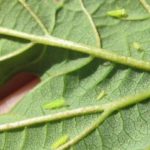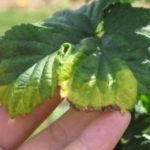 (Image: First, second, and third instar potato leafhopper nymphs.)
(Image: First, second, and third instar potato leafhopper nymphs.)
Potato leafhoppers (PLH) have arrived early this year and they were first spotted last week in Addison County hopyards. As the information is as relevant now as it was last year, we are re-posting this hop blog. Knowing what to look for and having a management plan to combat these pests will help in preventing plant damage and decreases in yields.
Potato leafhoppers overwinter in southern states and are carried north with the spring wind currents. Depending on winter temperatures, these insects can arrive in the Northeast between late spring and mid-June. The warmer the winter, the further these insects will travel north. Leaf hopper populations typically peak around July 1 depending on when they arrive and then start dying down around the beginning of August. PLH management should continue over the next couple of months.
When scouting for leafhoppers, hop leaves should be turned over and observed. PLH are long and skinny and move from side to side. Adults are larger than their nymph counterparts and are winged. When searching for adult potato leafhoppers, leaves of the hops plants can be shaken and the adults will often fly away.
PLH may be confused with aphids which are much less active, are round in shape and are often found between the midrib and veins of the leaves. Not properly managing the leafhopper can cause significant damage in hop yards and dramatically reduce yields. The leafhoppers have piercing-sucking mouthparts that damage the leaf tissue and stem phloem of the plants. This feeding technique causes necrosis of the leaf known as hopperburn, where the tip and outer edges of the leaf to yellow and then brown. Hopperburn reduces the photosynthetic capacity of the plant and thus reduces the energy available to produce cones. That said, it is imperative that leafhoppers are managed in some way or another.
For more information on PLH management in hops, see the following resources:
· Potato Leafhopper in Northeastern Hopyards fact sheet.
· Field Guide for Integrated Pest Management in Hops (https://www.usahops.org/resources/field-guide.html)
Remember to keep calm and hop on…
(Image: Hopperburn: visual V-shaped chlorosis injury caused by potato leafhopper.)
